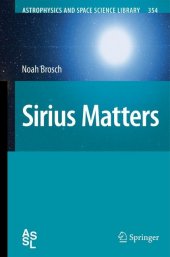 Neuerscheinungen 2013Stand: 2020-01-07 |
Schnellsuche
ISBN/Stichwort/Autor
|
Herderstraße 10
10625 Berlin
Tel.: 030 315 714 16
Fax 030 315 714 14
info@buchspektrum.de |

Noah Brosch
Sirius Matters
2013. xvii, 216 S. XVII, 216 p. 235 mm
Verlag/Jahr: SPRINGER NETHERLANDS 2013
ISBN: 9048178401 (9048178401)
Neue ISBN: 978-9048178407 (9789048178407)
Preis und Lieferzeit: Bitte klicken
Since very early times Sirius was a point of attraction in the night sky. It served to synchronize calendars in antiquity and was the subject of many myths and legends, including some modern ones. It was perceived as a red star for more than 400 years, but such reports were relegated to the Mediterranean region. Astronomically, Sirius is a very bright star. This, and its present close distance to us, argues in favor of it being the target of detailed studies of stellar structure and evolution. Its binary nature, with a companion that is one of the more massive white dwarfs, is an additional reason for such studies. This book collects the published information on Sirius in an attempt to derive a coherent picture of how this system came to look as it does.
1 SIRIUS MATTERS
2 Historical perspective
2.1 Introduction 2.2 Egypt and the ancient Middle East, 2.3 Ancient Greece and Rome, 2.4 Africa and Arabia .2.5 India, China, and the Far East, 2.6 North and South America, 2.7 Polynesia and Australia, 2.8 Jewish connections, 2.9 Conclusions
3 Mysteries of the Sirius System
3.1 The issue of historical redness, 3.2 Explanations for redness, 3.3 The binary nature of Sirius, 3.4 The Dogon tribe and a modern Sirius mystery, 3.5 Conclusions
4 Approaching modern times
4.1 The discovery of Sirius B: a tale of gravity
4.2 A third body in the Sirius system?, 4.3 Modern searches for a third companion, 4.4 Conclusions
5 Modern optical measurements
5.1 Astrometry, 5.1.1 The Hipparcos satellite, 5.2 Photometry, 5.3 Spectroscopy, 5.3.1 Rotation, 5.3.2 Magnetic field, 5.3.3 Gravitational redshift and spectra of Sirius B, 5.4 Conclusions
6 Modern non-optical observations, 6.1 Infrared, 6.2 UV and EUV measurements, 6.3 High energy observations, 6.4 Basic stellar parameters, 6.5 Conclusions
7 The neighborhood of Sirius
7.1 Interstellar matter, 7.2 Very small LISM structures in the Milky Way, 7.3 Stars in the neighborhood of Sirius, 7.4 Conclusions
8 The perspective of stellar structure
8.1 Upper main-sequence stars and Sirius A, 8.2 White dwarfs and Sirius B, 8.3 Conclusions
9 The perspective of stellar evolution
9.1 Evolution of a main-sequence A star: Sirius A, 9.2 Evolution of a white dwarf: Sirius B, 9.3 Binary star evolution: Sirius as population representative, 9.4 Conclusions
10 Sirius revealed-a synthesis of the information
10.1 Sirius analogs, 10.2 Sirius-basic data, 10.3 Synthesis of information, 10.3.1 Specific models for Sirius, 10.3.2 Red color in antiquity, 10.4 Conclusions
From the reviews:
"The author seems to have summarised almost everything that is known about Sirius. ... will be understandable to anyone with a basic knowledge of physics ... . There is a diversity of interesting pictures, graphs and diagrams, including satellite data and dramatic images ... . Brosch writes for the educated reader, and even non-scientists will be able to enjoy large parts of his opus, especially the historical and ethnographical sections. It is a delightful book that can be recommended warmly to all ... ." (Peter V. E. McClintock, Contemporary Physics, Vol. 51 (5), 2010)
Noah Brosch completed his first and second degrees at Tel Aviv University in Israel and received his PhD in Astronomy from the University of Leiden in the Netherlands for a study of isolated galaxies. Since 1983 he served in various functions at Tel Aviv University´s Wise Observatory, presently as Director. Brosch is also the Principal Investigator of the TAUVEX Ultraviolet Space Telescope, the first space astronomy mission of Israel, scheduled for a 2008 launch. He is a past Chairman of the Israel Astronomical Association and is a well-known science educator, popular science writer and lecturer. The main scientific interest of Noah Brosch is evolutionary processes in galaxies with emphasis on the dwarf galaxies, but he publishes papers on a variety of topics from objects in our Solar System, through space astronomy, to extragalactic research.


